Sunday 5 April 1942
 |
| HMS Cornwall sinking after being attacked by Japanese D3A1 "Val" dive-bombers on 5 April 1942. All pictures of this encounter were filmed by circling Japanese aircrew. |
Battle of the Indian Ocean: Major operations begin in the Japanese Indian Ocean Raid by the Kido Butai strike force. At dawn, Admiral Nagumo begins launching 127 planes (36 A6M2 fighters, 38 D3A1 bombers, and 53 B5N2 bombers) for a strike on Colombo, Ceylon (Sri Lanka). This becomes known as the "Easter Sunday Raid." The planes cause heavy damage to the port area and sink destroyer Tenedos (33 dead), passenger ship (requisitioned by the Royal Navy) Hector, and tanker Soli (only damaged and beached but declared a total loss). The Japanese lose 7 planes (1 A6M2 and 6 D3A1) to anti-aircraft fire and defending fire, while the defending RAF loses somewhat more than that, including an entire flight of six Swordfish of RAF No. 788 Squadron shot down by aircraft from Japanese carrier Hiryu. Just as during the Pearl Harbor attack, the force is commanded by Akagi flight leader Lt. Cdr Mitsuo Fuchida, who flies in an observation role.
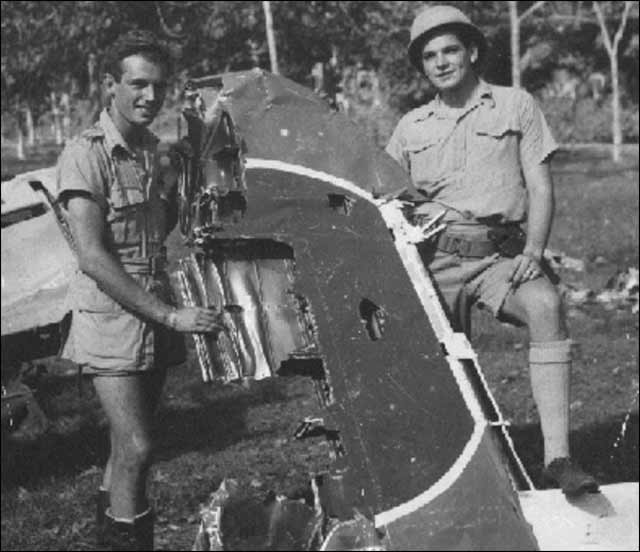 |
| The remains of one of five of Zuikaku's D3A1s shot down over Ratmalana airfield during the raid on Colombo, Ceylon, April 5, 1942. |
After this successful strike, Nagumo heads southwest, apparently to avoid retaliation. This leads him directly toward the British fleet steaming toward him from the Maldives, of which he is unaware. At 10:00, a floatplane from cruiser Tone spots the British ships. Nagumo increases speed and launches another strike at 11:54, this time against the ships. The torpedo planes sink cruisers Cornwall and Dorsetshire (234 of 653 crew dead) about 200 miles (370 km) southwest of Ceylon at 14:00.
Also bombed at some point during the day is British freighter Dardanus (actual sinking from Japanese naval gunfire on 6 April), and British freighter Harpasa. They both sink after being attacked by aircraft from aircraft carrier Ryujo.
Meanwhile, Admiral James Somerville closes on the scene, but Nagumo changes course again. Somerville receives spotty information from his reconnaissance planes, and he also changes course, this time to the southwest. This takes the British ships away from the Japanese fleet. Nagumo, aware that he has been spotted, decides to resume his original mission and swings south and then east. As the day ends, he is positioned for another attack on Ceylon, this time on Trincomalee, while Somerville's fleet is heading in the other direction.
Japanese submarines are operating in the Indian Ocean near Ceylon along with Kido Butai. I-5 torpedoes and sinks US freighter Washingtonian, while another submarine torpedoes and sinks British minesweeper Beaver.
 |
| A D3A1 taking off from Zuikaku on April 5, 1942. |
With things well in hand at Bataan, the Japanese feel free to expand their efforts in the Philippines. At Lingayen Gulf, a large invasion force of 4852 troops sails from Luzon toward Cebu Island in the Visayan Islands.
The Japanese complete the occupation of Buka and Bougainville in the Solomon Islands. These islands will serve as a shield for the main Japanese base at Rabaul just to the north. The first order of business is to build airfields on these new acquisitions to support operations further south against targets such as Guadalcanal. Meanwhile, nine B-26 bombers based in the Bismarck Archipelago attack Lakunai and Vunakanau Aerodromes at Rabaul on New Britain island in their first mission.
While fighting on land in Burma has died down temporarily, the war in the air continues unabated. The 1st and 3d Fighter Squadrons of the American Volunteer Group (AVG, or Flying Tigers) down a dozen Japanese planes near Loiwing Aerodrome.
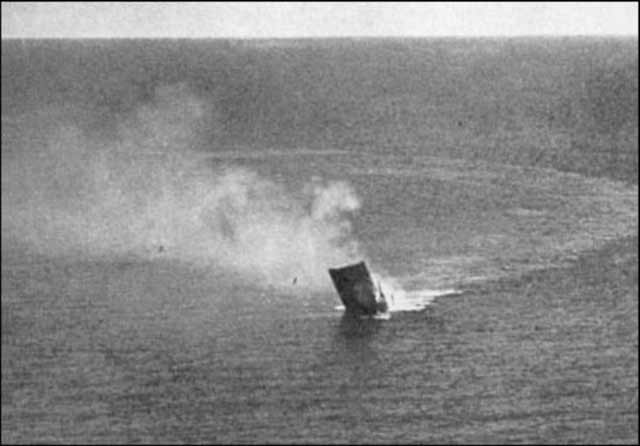 |
| HMS Dorsetshire sinks on 5 April 1942. |
Japanese troops also occupy Lorengau on Manus Island. They are brought there by a naval force led by light cruiser HIJMS Tatsuta, destroyer Mutsuki, and troop transport SS Mishima Maru. A small Australian force of B Platoon of the First Independent Company has no chance of defending against the hundreds of Japanese soldiers and withdraws into the jungle.
Australian 120 ton transport Wauchope runs aground and is lost off Port Stephens, Nelson's Bay, Box Beach.
Eastern Front: Adolf Hitler issues one of his most famous orders, Fuhrer Directive No. 41. This forms the basis for Case Blue, an offensive in southern Russia to occupy the Caucasus oil fields (the operational name "Case Blue" comes later). As the order provides:
Luftwaffe air attacks by III/KG 30 continue at Murmansk. Today, they sink Soviet naval trawler RT-61 and sinks trawler RT-7-SEMGA. At Murmansk, emergency repairs are completed on Royal Navy destroyer Eclipse.
 |
| Royal Navy cruisers Dorsetshire and Cornwall desperately try to avoid being bombed and torpedoed before being sunk on 5 April 1942. |
In pursuit of the original plan for the Eastern campaign, the armies of the central sector will stand fast, those in the north will capture Leningrad and link up with the Finns, while those on the southern flank will break through into the Caucasus.
Needless to say, these instructions are not in accordance with the "original plan" for Operation Barbarossa except in general intent. The original plans - vague as they were - envisioned the front being much further east than it actually is on 5 April 1942. If the original plans for Operation Barbarossa had become reality, there would be no need for another offensive in Russia.
However, Hitler does return to the original vision of taking Leningrad and objectives in the south rather than Moscow. The Soviet capital now drops completely off the radar screen after becoming the target late in 1941 with Operation Typhoon. As such, Fuhrer Directive No. 41 re-establishes Hitler's primacy over the generals, who almost uniformly view Moscow as the most important objective on the Eastern Front.
A distinguishing feature of Fuhrer Directive No. 41 is its attention to minute detail. "We must avoid closing the pincers too late," Hitler cautions at one point, which seems an elementary thing to put in such an expansive campaign order. However, recently Hitler has been assuming more and more control over military operations. Dwelling on tactics just mirrors the changes going on at Fuhrer headquarters.
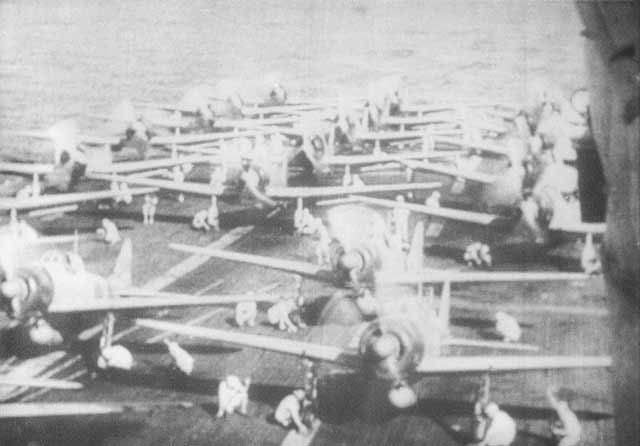 |
| Aircraft ranged on Akagi's deck ready to strike at the heavy cruisers Cornwall and Dorsetshire, April 5, 1942. |
Another striking feature is a theme of assumed superiority, even domination. Even the first line - "The winter battle in Russia is nearing its end" - is questionable, considering that the German pockets at Demyansk and Kholm still need to be relieved. Winter certainly is nearing its end, but not the battles that began then. Fuhrer Order No. 41 does not even contemplate a Soviet offensive despite the many indications that the Red Army remains strong. It is German, not Soviet, conditions that matter. Soviet plans are irrelevant in the world of this Directive.
Further down the order, it notes that during these "preliminary operations," there will be "a mop-up operation in the Kerch Peninsula in the Crimea and the capture of Sevastopol." In fact, the outcome in Crimea remains very much in doubt and local commander General Manstein has had his hands full just maintaining his lines. But, the order just wishes these issues away. After these "preliminary" matters are completed, the order states it will be time to take Voronezh and then head to Stalingrad (mentioned in orders for the first time). Nothing is specified beyond that, suggesting that Stalingrad is the end-point for the year's summer operations.
 |
| Japanese aircraft carrier Ryujo preparing to launch Aichi D3A Type 99 dive bombers on or about 5 April 1942. |
Critically, the Directive doesn't even require capturing Stalingrad:
In any event, every effort will be made to reach Stalingrad itself, or at least to bring the city under fire from heavy artillery so that it may no longer be of any use as an industrial or communications center.
It is not to reveal any secrets to say that Fuhrer Directive No. 41 is followed almost to the letter during the summer of 1942. Virtually everything projected in it comes to pass despite its many shaky assumptions. This is the result of some Soviet missteps that play right into Hitler's hands. Fuhrer Directive No. 41 becomes one of the most successful campaign plans in history. Following it as written, though, leads to the Reich's ruin because the objectives themselves are faulty. But. let's not get ahead of ourselves.
With Directive No. 41, Hitler decides the fate of millions of people. The fate of the Reich will depend upon this successful lunge south to the oil fields.
Luftwaffe air attacks by III/KG 30 continue at Murmansk. Today, they sink Soviet naval trawler RT-61 and sinks trawler RT-7-SEMGA. At Murmansk, emergency repairs are completed on Royal Navy destroyer Eclipse.
In addition, 20 Whitley bombers attack the Gnome & Rhone engine factory in Paris/Gennevilliers. Once again, the intended target emerges unscathed, with one house destroyed and four others damaged. There are no casualties and no aircraft lost.
In minor operations, 18 aircraft bomb Le Havre, six Blenheims attack Holland, and 11 Wellingtons and Hampdens lay mines off the French coast with no losses.
 |
| US tanker Byron D. Benson sinks off North Carolina, 5 April 1942. |
U-552 (Kptlt. Erich Topp), on its eighth patrol out of St. Nazaire, continues its most successful patrol of the war when it sinks 7953-ton US tanker Byron D. Benson. The sinking 7 1/2 miles off Currituck Inlet, North Carolina, leaves 10 dead and 27 survivors. The situation becomes worse than it might be otherwise when men begin abandoning ship without orders while the ship is still sailing at six knots. This momentum leaves men trying to survive burning oil in water while in their lifeboats. It takes three days for the burning tanker to sink.
British 872-ton coaster Empire Beacon hits a mine and sinks in Bristol Channel off St. Ann's Head, Pembrokeshire.
British 938-ton freighter Feddy sinks after colliding with trawler Visenda off North Ronaldsay.
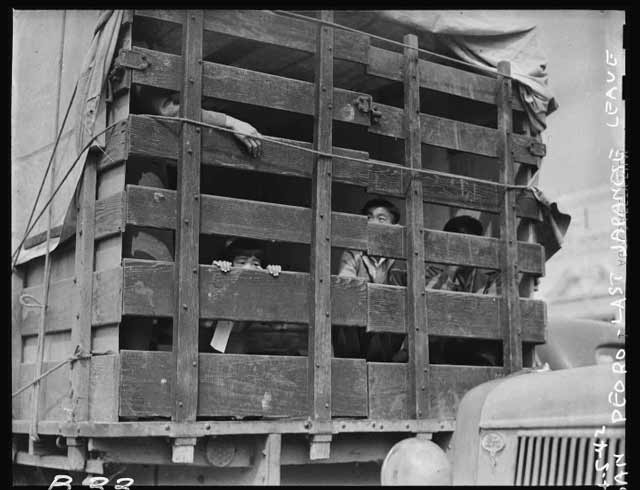 |
| Refugees heading to an internment camp. Clem Albers, “San Pedro, California, April 5, 1942” (courtesy National Archives and Records Administration). |
Royal Navy submarine Una torpedoes and sinks Italian freighter Ninetto G. east of Syracuse, Sicily. there are two dead and 28 survivors.
Special Operations: British Nos. 1 and 6 Commandos undertake Operation Myrmidon. This is a raid on the Adour Estuary (near Bayonne) in southwest France. The plan is to land 3000 Commandos, disrupt land communications in the vicinity, and then reembark. There has been a lot of preparation for this operation, with the troops sailing quietly on transport ships Queen Emma and Princess Beatrix for a month along the coast to allay any German suspicions.
When the Commandos finally decide to carry out the mission, however, everything quickly goes wrong. The ships encounter an unexpected sandbar - which almost ruined the highly successful recent raid on St. Nazaire - and the decision is made to abort the entire mission. After all that preparation, the Commandos simply return to England. Operation Myrmidon is canceled.
US/Canadian Relations: To help the US solve a supply bottleneck for supplies to Alaska at Seattle, Canadian authorities allow US ships to use Port Rupert, British Columbia.
US Military: Two US warplanes crash within hours of each other during a storm on Oahu, Hawaii, killing nineteen servicemen. The first is Navy PBY-5A out of NAS Kaneohe, which crashes at Makapu'u. The second plane is a B-17E that crashes into the cliffs of Mt. Keahiakahoe near the Nu'uanu Pali. Relatives of the crew of the B-17E place a granite crew memorial at the Pali Lookout on April 1, 2007.
Norwegian Homefront: Lutheran ministers continue their protest of the German occupation. In Oslo, 654 of 699 ministers resign from their civil service positions in a demonstration of widespread disobedience to the occupying authorities.
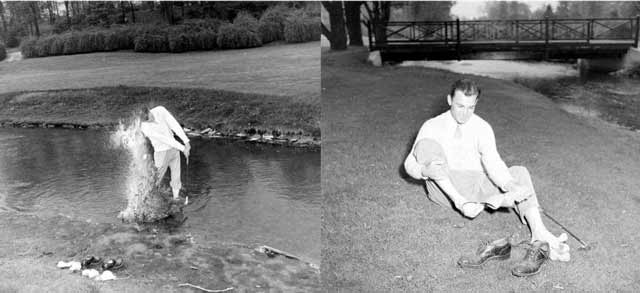 |
| Ben Hogan demonstrating how he handles water hazards after winning the Asheville tournament on 5 April 1942. |
American Homefront:
Ben Hogan shoots a final round 68 to win the Asheville Land of the Sky Open. He earns $1,000 in war bonds for the victory.
Future History: Harold Allan Clarke is born in Salford, Lancashire, England. He becomes one of the founding members of the rock group The Hollies in the 1960s. During his time with the group, he helps to write hits such as "On a Carousel," "Carrie Anne," "Jennifer Eccles," and "Long Cool Woman in a Black Dress." He later pursues a solo career. Allan Clarke is inducted into the Rock and Roll Hall of Fame in 2010 and remains active in the music scene.
Peter Greenaway is born in Newport, Wales. Peter plans on becoming a painter but gravitates into filmmaking. He begins making experimental films in the 1960s and develops his craft until releasing the highly successful "The Cook, the Thief, His Wife & Her Lover" (1989). Many of Greenaway's later projects focus on famous artwork, such as his 2006 series "Nine Classical Paintings Revisited." As of 2020, Peter Greenaway remains active in various forms of European cinema, television, and video, many projects focusing on his love of famous art and music.
 |
| Japanese-American evacuees board a train at the Santa Anita Assembly Center. April 5, 1942 (National Archives). |
April 1942
April 1, 1942: Convoys Come to the USAApril 2, 1942: Doolittle Raiders Leave Port
April 3, 1942: Japanese Attack in Bataan
April 4, 1942: Luftwaffe Attacks Kronstadt
April 5, 1942: Japanese Easter Sunday Raid on Ceylon
April 6, 1942: Japanese Devastation In Bay of Bengal
April 7, 1942: Valletta, Malta, Destroyed
April 8, 1942: US Bataan Defenses Collapse
April 9, 1942: US Defeat in Bataan
April 10, 1942: The Bataan Death March
April 11, 1942: The Sea War Heats Up
April 12, 1942: Essen Raids Conclude Dismally
April 13, 1942: Convoy QP-10 Destruction
April 14, 1942: Demyansk Breakout Attempt
April 15, 1942: Sobibor Extermination Camp Opens
April 16, 1942: Oil Field Ablaze in Burma
April 17, 1942: The Disastrous Augsburg Raid
April 18, 1942: The Doolittle Raid bombs Japan
April 19, 1942: British in Burma Escape
April 20, 1942: The Operation Calendar Disaster
April 21, 1942: Germans Relieve Demyansk
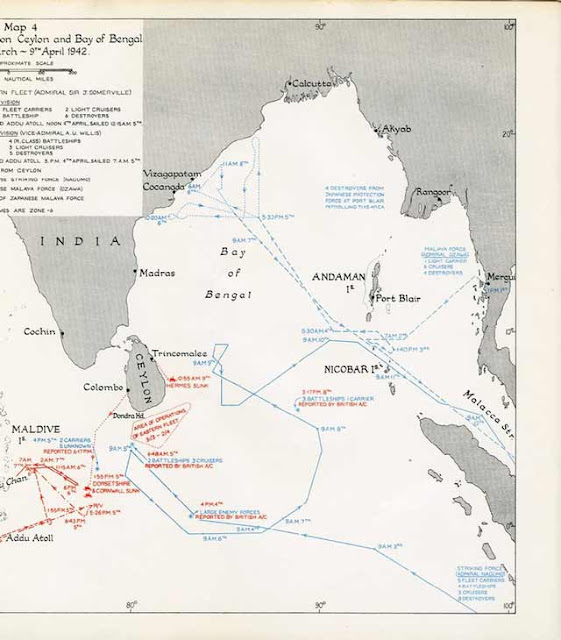
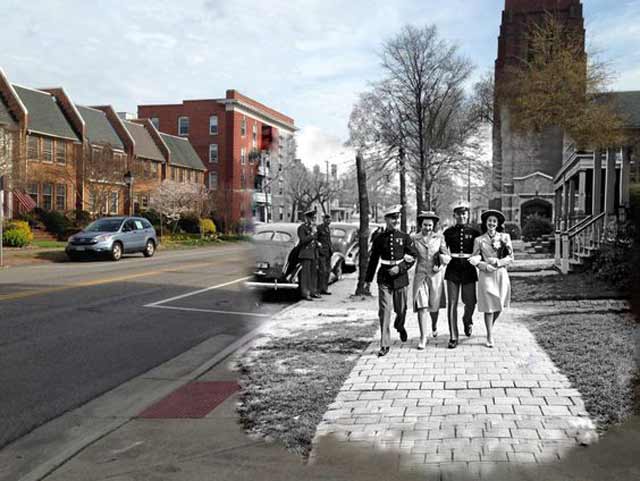
No comments:
Post a Comment